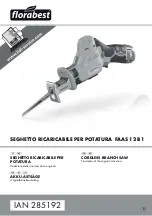
27 ENGLISH
(a) (b)
(c) (d)
1
2
1.
Inside corner
2.
Outside corner
Table (C)
–
Molding
position in
the figure
Miter angle
Finished
piece
For inside
corner
(a)
Right 45°
Save the right
side of blade
(b)
Left 45°
Save the left
side of blade
For outside
corner
(c)
Save the right
side of blade
(d)
Right 45°
Save the left
side of blade
Cutting aluminum extrusion
►
Fig.52:
1.
Vise
2.
Spacer block
3.
Guide fence
4.
Aluminum extrusion
5.
Spacer block
When securing aluminum extrusions, use spacer blocks
or pieces of scrap as shown in the figure to prevent
deformation of the aluminum. Use a cutting lubricant
when cutting the aluminum extrusion to prevent build-up
of the aluminum material on the blade.
WARNING:
Never attempt to cut thick or
round aluminum extrusions.
Thick or round alumi-
num extrusions can be difficult to secure and the work
may loosen during the cutting operation which may
result in loss of control and serious personal injury.
Wood facing
WARNING:
Use screws to attach the wood
facing to the guide fence. The screws should be
installed so that the screw heads are below the
surface of the wood facing so that they will not
interfere with the positioning of the material being
cut.
Misalignment of the material being cut can case
unexpected movement during the cutting operation
which may result in a loss of control and serious
personal injury.
CAUTION:
Use straight wood of even thick-
ness for the wood facing.
CAUTION:
In order to completely cut through
workpieces with a height of
107
mm to
120
mm, a
wood facing should be used on the guide fence.
The wood facing will space the workpiece away from
the fence allowing the blade to complete a deeper
cut.
NOTICE:
When the wood facing is attached, do
not turn the turn base with the handle lowered.
The blade and/or the wood facing will be damaged.
Use of wood facing helps to assure splinter-free cuts
in workpieces. Attach a wood facing to the guide fence
using the holes in the guide fence and 6 mm screws.
See the figure concerning the dimensions for a sug
-
gested wood facing.
►
Fig.53:
1.
Hole
2.
Over 15 mm
3.
Over 270 mm
4.
90 mm
5.
145 mm
6.
19 mm
7.
115 -
120 mm
EXAMPLE
When cutting workpieces 115 mm and
120 mm high, use a wood facing with the following
thickness.
Miter angle
Thickness of wood facing
115 mm
120 mm
0°
20 mm
38 mm
Left and Right 45°
15 mm
25 mm
Left and Right 60°
15 mm
25 mm
Groove cutting
WARNING:
Do not attempt to perform this
type of cut by using a wider type blade or dado
blade.
Attempting to make a groove cut with a wider
blade or dado blade could lead to unexpected cutting
results and kickback which may result in serious
personal injury.
WARNING:
Be sure to return the stopper arm
to the original position when performing other
than groove cutting.
Attempting to make cuts with
the stopper arm in the incorrect position could lead to
unexpected cutting results and kickback which may
result in serious personal injury.
For a dado type cut, perform as follows:
1.
Adjust the lower limit position of the blade using
the adjusting screw and the stopper arm to limit the cut
-
ting depth of the blade. Refer to "Stopper arm" section
described on previously.
2.
After adjusting the lower limit position of the blade,
cut parallel grooves across the width of the workpiece
using a slide (push) cut.
►
Fig.54:
1.
Cut grooves with blade
3.
Remove the workpiece material between the
grooves with a chisel.
Summary of Contents for 122088
Page 2: ...Fig 1 10 11 12 14 15 3 2 4 5 8 7 9 13 6 1 16 17 18 19 20 21 Fig 2 2 ...
Page 3: ...7 8 5 6 1 2 3 4 9 10 11 15 13 12 14 Fig 3 1 2 Fig 4 1 3 2 4 Fig 5 3 ...
Page 4: ...1 3 2 Fig 6 1 Fig 7 1 Fig 8 3 1 2 Fig 9 1 Fig 10 1 2 3 4 6 5 Fig 11 4 ...
Page 5: ...1 Fig 12 1 Fig 13 1 3 2 Fig 14 1 2 Fig 15 1 3 2 4 Fig 16 1 Fig 17 5 ...
Page 6: ...1 Fig 18 1 2 Fig 19 1 Fig 20 1 Fig 21 1 Fig 22 3 2 1 Fig 23 1 2 3 Fig 24 6 ...
Page 7: ...1 Fig 25 1 Fig 26 A B Fig 27 1 Fig 28 3 1 2 Fig 29 7 ...
Page 8: ...3 1 2 Fig 30 2 3 1 4 5 Fig 31 1 2 Fig 32 1 2 3 4 5 6 Fig 33 3 1 2 Fig 34 8 ...
Page 9: ...1 2 Fig 35 1 Fig 36 1 2 Fig 37 1 2 4 3 2 1 3 4 Fig 38 2 3 1 Fig 39 1 2 3 4 Fig 40 9 ...
Page 10: ...1 2 3 Fig 41 2 1 Fig 42 1 Fig 43 1 Fig 44 Fig 45 10 ...
Page 11: ...1 2 3 Fig 46 1 2 3 Fig 47 2 3 1 4 Fig 48 1 2 3 4 Fig 49 1 4 2 3 Fig 50 2 1 Fig 51 11 ...
Page 13: ...1 Fig 60 2 1 Fig 61 1 2 3 Fig 62 Fig 63 1 2 Fig 64 13 ...
Page 14: ...4 5 1 3 2 Fig 65 1 4 2 3 5 Fig 66 1 2 Fig 67 1 Fig 68 1 Fig 69 14 ...
















































